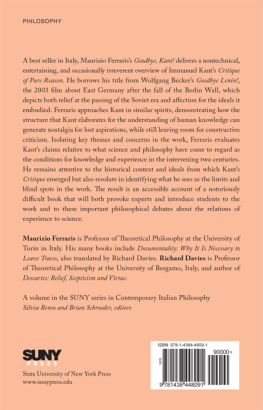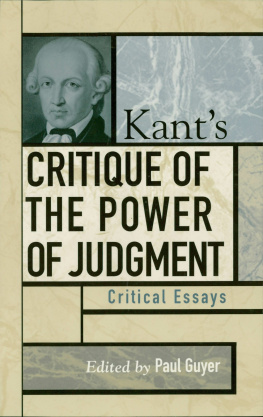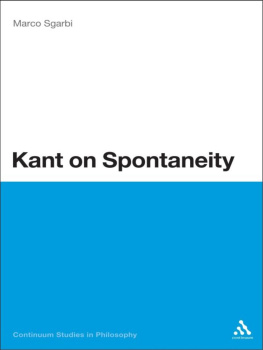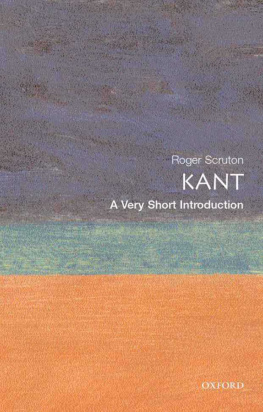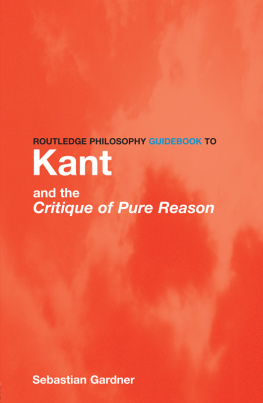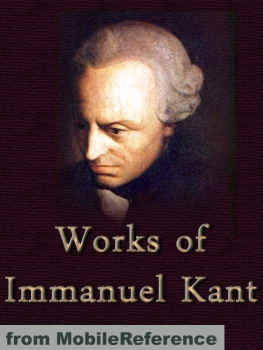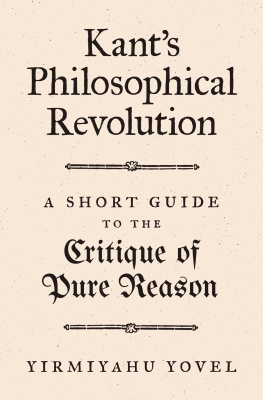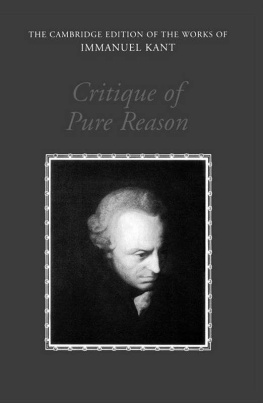Goodbye, Kant!
SUNY series in Contemporary Italian Philosophy
Silvia Benso and Brian Schroeder, editors
Goodbye, Kant!
What Still Stands of the
Critique of Pure Reason
Maurizio Ferraris
Translated by
Richard Davies
Published by State University of New York Press, Albany
2013 State University of New York
Originally published in Italian as Goodbye, Kant!
RCS Libri Milano, Bompiani, 2004
All rights reserved
Printed in the United States of America
No part of this book may be used or reproduced in any manner whatsoever without written permission. No part of this book may be stored in a retrieval system or transmitted in any form or by any means including electronic, electrostatic, magnetic tape, mechanical, photocopying, recording, or otherwise without the prior permission in writing of the publisher.
For information, contact State University of New York Press, Albany, NY
www.sunypress.edu
Production by Eileen Nizer
Marketing by Anne M. Valentine
Library of Congress Cataloging-in-Publication Data
Ferraris, Maurizio,
[Goodbye, Kant! English]
Goodbye, Kant! : what still stands of the critique of pure reason / Maurizio Ferraris ; translated by Richard Davies.
pages cm. (SUNY series in contemporary Italian philosophy)
ISBN 978-1-4384-4809-1 (alk. paper)
1. Kant, Immanuel, 17241804. Kritik der reinen Vernunft. I. Davies, Richard (Richard Brian), 1944 translator. II. Title.
B2779.F47313 2013
121dc23
2012045702
10 9 8 7 6 5 4 3 2 1
Contents
List of Figures
Introduction
From Knigsberg to Kaliningrad
Knigsberg, where Kant was born and lived, is one of the many cities that changed its name after the Second World War. Then it was in Prussia; today it is a Russian enclave between Poland and Lithuania and is called Kaliningrad. Its passing in 1945 from German to Russian seems to mirror the return of Leningrad/St. Petersburg from Russian to German after 1989. And it helps us to realize, as if on a journey through time rather than space, how much water had flowed under the bridge, not only in history (which is obvious enough) but also in philosophy (which is often less so).
Prompted by the bicentennial of Kants death, this brief essay aims to set out his revolution, the so-called Copernican revolution, with the same affectionate irony with which the film Goodbye Lenin! treats the Soviet revolution.
The spirit in which we proceed is thus quite different from that which, 150 years ago, drove Franz Phonsk (17881859), a pupil of the Austrian philosopher Bernhard Bolzano (17811848), to write a book whose title represents its program, The New Anti-Kant,so vast a task?), but to present from anotherperhaps better-disposedpoint of view a classic of philosophy that has become embalmed by the passage of time and its own success.
February 12, 2004
M. F.
Kants revolution
Why start a revolution
When he died at the age of eighty on the February 12, 1804, Kant was as forgetful as Ronald Reagan was at the end of his life. To overcome this, he wrote everything down on a large sheet of paper, on which metaphysical reflections are mixed in with laundry bills. He was the melancholy parody of what Kant regarded as the highest principle of his own philosophy, namely that an I think must accompany every representation or that there is a single world for the self that perceives it, that takes account of it, that remembers it, and that determines it through the categories.
This is an idea that had done the rounds under various guises in philosophy before Kant, but he crucially transformed it. The reference to subjectivity did not conflict with objectivity, but rather made it possible inasmuch as the self is not just a disorderly bundle of sensations but a principle of order endowed with two pure forms of intuitionthose of space and timeand with twelve categoriesamong which substance and causethat constitute the real sources of what we call objectivity. The Copernican revolution to which Kant nailed his philosophical colors thus runs as follows: Instead of asking what things are like in themselves, we should ask how they must be if they are to be known by us.
It is still worth asking why Kant should have undertaken so heroic and dangerous a task and why he, a docile subject of the enlightened despot the King of Prussia, to whom he had once even dedicated a poem, should have had to start a revolution. Unlike the causes that brought about the political revolutions of modern times, Kants motives do not seem so very clear; yet, from a conceptual point of view, they turn out to be no less powerful and convincing.
Put simply, Kant too had no choice in the matter, given that philosophy as it was practiced at the time had reached a dead end, hanging for all that it is (as we shall see in nauseating detail) highly debatable as a theoretical stance, offers a very exact portrait of the historical situation for which Kant sought to supply a cure. Thus, we may begin trying to see which forces were in action on the philosophical scene in the second half of the eighteenth century.
The rationalists and the Library of Babel
The rationalists, many of whom were German professors, looked back to the great reconciler that was Gottfried Wilhelm Leibniz (16461716). Suffice it to say that Leibniz dedicated himself to bringing harmony between Catholics and Protestants, to distracting Louis XIV from taking aim at Germany in favor of Egypt, and even to bringing peace between the modern philosophy that began with Descartes (15961650) and the Scholasticism that drew inspiration from Aristotle. For this reason, rationalism can be identified in large part with the Schulphilosophie that brought medieval Scholasticism up to date with large doses of Cartesianism.
The rationalists underlying idea was that we know through concepts. Knowing what an object is amounts to being able to list its features: soul is an unextended thing, body is an extended thing, a dog is a soulless domestic quadruped. In this spirit, the composition of a book of metaphysics is roughly the orderly formulation of definitions that are then combined in rational form so as to avoid contradictions. By the systematic aggregation of concepts, it becomes possible to realize the dream, first conceived in the Middle Ages by Raymond Lull (12321316) and then renewed in the Renaissance and in Descartess time, of a combinatorial art that promised universal knowledge by means of the composition of concepts and, ultimately, of words.
How was an art of this sort supposed to work? And, above all, did it work? Suppose we have to determine how many angels can dance on a pinhead. By definition, millions, given that, as we read in the dictionary, angels are pure spirits and have no body. Thus we have a ready answer: as many angels as you like can dance on a pinhead, just as there are infinitely many lines that pass through a point. If anyone objected that he had never seen an angel, the obvious answer would be that of course he hadnt because angels, being unextended, cannot be seen. This
Kant loathed this way of doing metaphysics. He was curious about the sciences and about travel, even though he himself never left Knigsberg and its immediate environs, and he did not believe that dictionaries add anything to our knowledge. Moreover, he inherited a hatred for intellectualism from his professor of philosophy, Martin Knutzen (17131751), an early critic of hyper-rationalism. This is the source of his accusation against the Leibnizians that they did nothing but spin and weave purely nominal definitions in such a way that their metaphysical works were, at best, dictionaries and, at worst, fantasies born out of the combinations of words.

